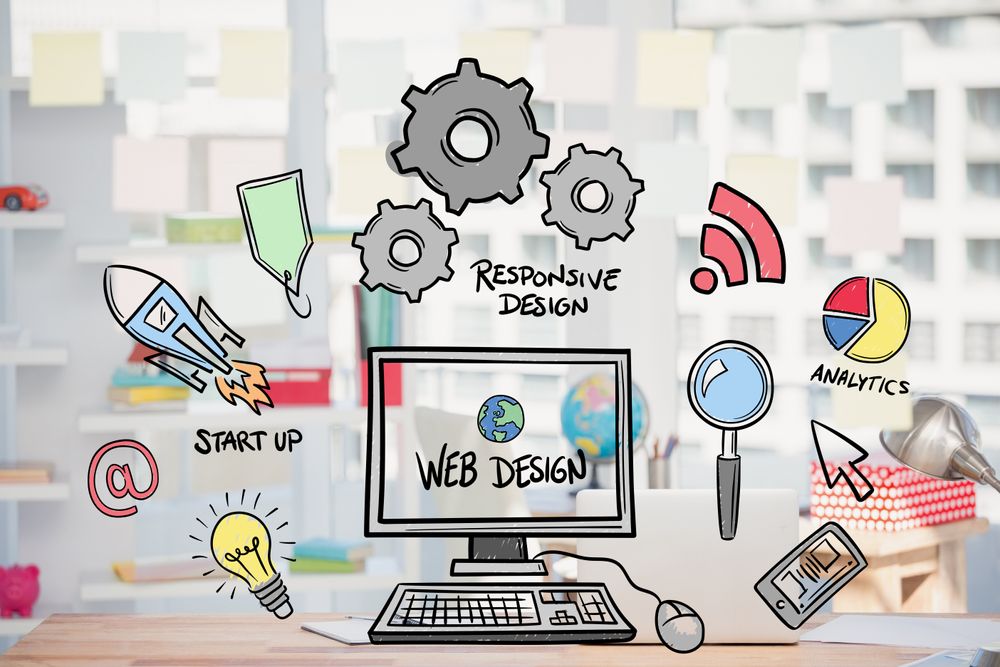How Ingenious Web Design Can Transform Your Brand Identity
Innovative web design plays an essential function in forming a brand name's identity. It acts as the electronic store front, affecting first impacts and user involvement. Thoughtful design choices can create remarkable experiences and foster loyalty. However, the impact goes beyond visual appeals. Understanding the underlying concepts of effective web design can disclose its true capacity. What strategies might be utilized to assure that a brand name not only stands out however likewise reverberates with its target market?
The Relevance of First Impressions in Web Design
Just how necessary is an initial impact in the domain of web design? It works as the initial portal to user interaction, establishing whether visitors will certainly discover more or abandon the site. A website's visual and capability can substantially influence assumptions of a brand's reliability and expertise. In an age where digital communications are instant, customers develop opinions within seconds, making aesthetic appeal and user-friendly navigating important.
A reliable first perception can foster trust and encourage expedition, while a badly made interface may evoke frustration and skepticism. Components such as shade systems, typography, and format all add to this initial understanding. Additionally, uniformity in layout throughout all web pages reinforces brand identification. Consequently, the relevance of impressions in web design can not be overstated; they not just dictate user retention but also effect overall user experience and contentment, eventually forming a brand's reputation in an affordable online landscape.
Crucial Element of Efficient Web Design
A website's effectiveness depends upon a number of crucial elements that operate in harmony to develop a favorable user experience. User-friendly navigation is crucial, permitting customers to locate information effortlessly. Clear and succinct content improves understanding and involvement, while tactical usage of whitespace prevents frustrating the visitor.
Receptive style is one more necessary facet, making sure that the web site operates well on different tools and screen sizes. Fast loading times are essential; slow-moving websites can cause high bounce prices.
Visual elements, consisting of top notch pictures and an appealing layout, contribute to a cosmetically pleasing experience that reverberates with customers. Ultimately, availability ought to not be overlooked, as it ensures that all customers, regardless of capacity, can interact with the site.
Exactly How Shade Psychology Influences Brand Assumption
Shade psychology plays a crucial duty in forming brand name perception, influencing customer feelings and actions in profound means. Different colors evoke certain sensations; for instance, blue frequently conveys trust and expertise, while red can elicit excitement or seriousness. Brands purposefully leverage these organizations to improve their identity and get in touch with their target audience.
For example, a technology company might make use of a sleek blue palette to project dependability, while a food brand might go with dynamic reds and yellows to promote cravings and power - Web Design Agency. The uniformity of color across numerous platforms reinforces brand name recognition and fosters loyalty

Enhancing User Experience With Cutting-edge Attributes
Many innovative attributes can considerably boost user experience in web design, producing an extra appealing and intuitive communication for visitors. Interactive components such as dynamic material, computer animations, and responsive style assurance that customers remain mesmerized and entailed. Incorporating functions like chatbots can supply real-time aid, improving interaction and dealing with user queries immediately.
Furthermore, personalized material based on user habits promotes a customized experience, urging extended involvement. Accessibility features, consisting of voice navigating and screen viewers, assure inclusivity for all users, additionally enhancing general satisfaction.
Executing user-friendly navigating, such as sticky food selections and breadcrumb tracks, enables users to discover information effortlessly, decreasing irritation. Furthermore, integrating micro-interactions, like refined computer animations during switch clicks, can supply positive responses, enhancing user actions. Eventually, these innovative attributes function collectively to develop a smooth and pleasurable user experience, significantly boosting the overall understanding of a brand name.
Case Studies: Brands That Transformed Their Identity Via Web Design
Website design plays an essential duty in shaping a brand's identification, as confirmed by various business that have effectively redefined from this source their image with read review innovative on the internet experiences. A noteworthy example is Airbnb, which overhauled its website to concentrate on storytelling and user-generated material. This strategy not just enhanced user engagement but likewise enhanced its community-centric brand identification.
The rebranding of Dropbox with a minimalist layout emphasized simplicity and capability, aligning completely with its goal to make file sharing easy. The brand-new visual identity fostered a modern and trustworthy photo.
Another instance is Mailchimp, which moved from a simple e-mail advertising tool to a full-fledged marketing system. Its dynamic layout and lively images reflect a friendly and innovative brand name individuality, interesting a wider audience.
These improvements highlight how critical web design can significantly affect understanding, eventually driving brand commitment and market growth. - agency for web design
Regularly Asked Inquiries
Just How Much Does Cutting-edge Web Design Usually Price?
Innovative web design typically sets you back in between $2,500 to $15,000, relying on intricacy, features, and designer know-how. Customized solutions may surpass this array, mirroring the financial investment in quality and capability that boosts user experience.

What Are the current Web Design Patterns to Watch?
The most up to date web design trends include minimalism, strong typography, dark setting, interactive elements, and immersive narration. These components improve user experience, ensuring sites continue to be interesting and visually appealing in an increasingly digital landscape.
For how long Does a Website Design Job Usually Take?
A website design job generally takes in between 4 to twelve weeks, depending on elements such as complexity, client feedback, and the design team's work. Timelines may differ substantially based on particular job needs and goals.
Can I Upgrade My Site Without Losing Search Engine Optimization Rankings?
Yes, a website can be revamped without losing search engine optimization positions. Mindful preparation, keeping URL structures, maximizing on-page elements, and upgrading backlinks help protect presence in internet search engine during and after the redesign procedure.
What Platforms Are Ideal for Carrying Out Innovative Web Design?
Popular platforms for innovative web design consist of WordPress, Wix, and Squarespace. Each deals one-of-a-kind features, design templates, and personalization choices, enabling users to produce visually appealing and practical internet sites that line up with their brand name identity.
Cutting-edge web layout plays an important role in shaping a brand's identity. Countless innovative functions can greatly improve user experience in web design, creating a much more interesting and intuitive interaction for visitors. Website Design Agency. Interactive elements such as vibrant material, animations, and receptive layout warranty that users continue to be astounded and entailed. Web style plays a pivotal function in go to the website forming a brand's identity, as confirmed by numerous firms that have effectively redefined their picture via ingenious on-line experiences. A web design job normally takes in between 4 to twelve weeks, depending on aspects such as complexity, customer responses, and the layout team's workload